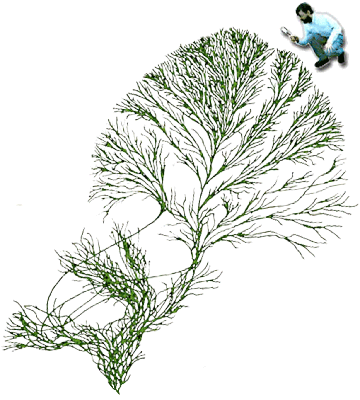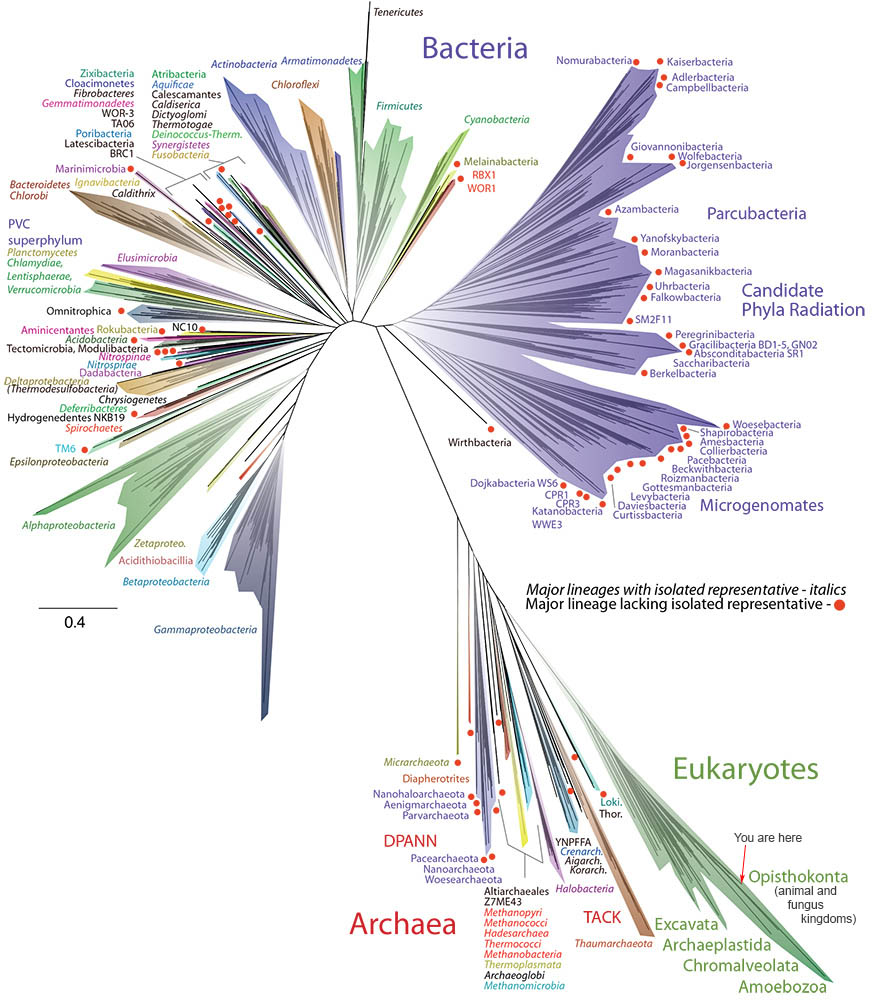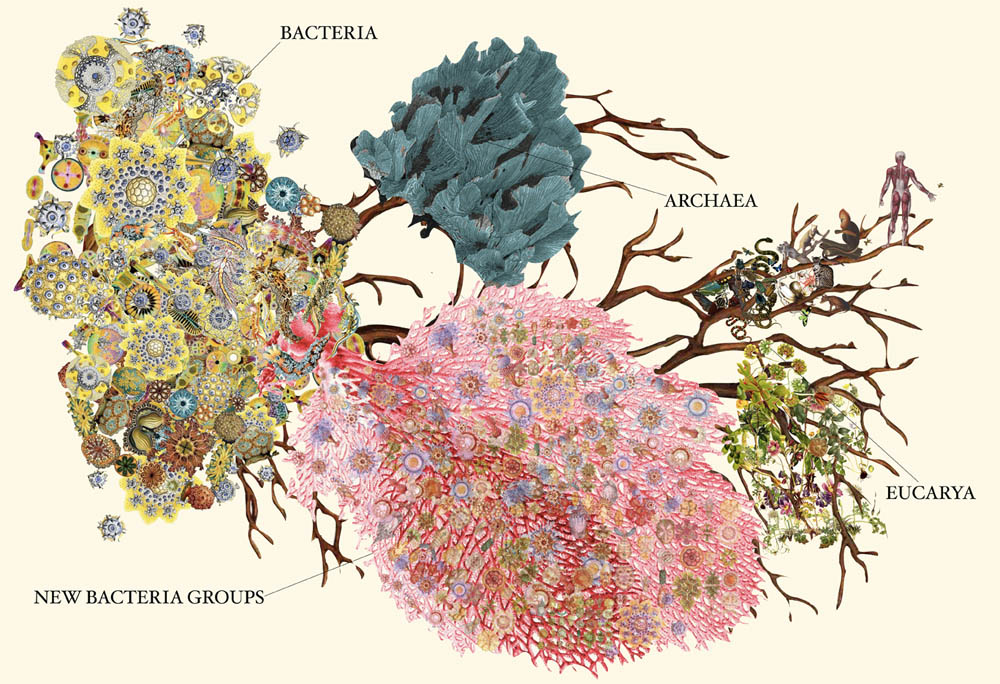Chapter 1
The Ascent of Life
- In the beginning was the inflation from which light cameth as did the particles—from which all stars, quasars, galaxies, clusters of galaxies, superclusters, planets, moons, dust, and organisms did form.
- In a galaxy, one among trillions, from the dust of first generation stars, did arise Sol having a Class M planet upon which an abiotic replicator begat more like unto itself, evolving into deoxyribonucleic acid information based subsystems, which did biotically replicate more like unto itself.
- With genes did information come into being, a thing new under the sun, and its value grew over the eons—know thee the sanctity of information.
- And Lo, there were rays from the heavens, and mutation came to pass with error correction. And the deoxyribonucleic acid begat prokaryotes. And there was variation amongst them, and competition, so that some thrived; but others vanished from the planet—natural selection be praised!
 And prokaryotes multiplied upon the face of the planet: the true bacteria, the mitochondria, and the chloroplasts; and the archaebacteria. And the mitochondria and chloroplasts knew the prokaryotes, and they cleaved to one another. And together they begat the eukaryotes who were nucleated unto themselves. But the prokaryotes shall remain the inheritors of the Pale Blue Dot unto the end of days.
And prokaryotes multiplied upon the face of the planet: the true bacteria, the mitochondria, and the chloroplasts; and the archaebacteria. And the mitochondria and chloroplasts knew the prokaryotes, and they cleaved to one another. And together they begat the eukaryotes who were nucleated unto themselves. But the prokaryotes shall remain the inheritors of the Pale Blue Dot unto the end of days.
- Now the eukaryotes multiplied greatly, and they begat sixty or more lineages of protozoans, red algae, flagellates, ciliates, diatoms, brown algae, giardia, slime molds, slime nets, red seaweeds and other wonders; but also they begat the opisthokonts, the begetter of the creature that begat the plants, and which also begat the microsporidia and the fungi, and the choanoflagellates, and the metazoa—also to be known as animals.
- And the plants and animals and fungi are close kin, and together they departed from the other lineages.
- The animals also knew each other in their day. Over the generations they divided amongst themselves and begat sponges and placozoa, and also the eumetazoa—the comb-jellies, as well as the cnidarians also known as jellyfish, sea anemones, corals and hydra. And the eumetazoa had tissues and organs. And they also begat the bilateria, which are the same on the left and on the right and have three layers of cells, and among these are many worms, and many are the children of worms.
- Now the bilateria begat two great nations of worms who were the protostomes. These were the lophotrochozoa, which begat the molluscs, earthworms, leeches and their many kindred; and the ecdysozoa, which begat the roundworms and also the arthropods or insects, who are in number like the stars in the heavens. Among them too are spiders and crabs and their many kindred.
- But also the bilateria begat the deuterostomes, whose anus is created through gastrulation before its mouth. And the deuterostomes are also in the likeness of worms. And know that ye are of the deuterostomes, because when thou art newly formed in thy mother's womb, yea verily, thy anus is open even before thy mouth.
- After some time, the deuterostomes begat the echinoderms which are the sea urchins and starfish and many others too; also the hemichordates; and the chordates, whose back is stiffened by a rod and who have a dorsal nerve. The chordates begat the generations of the urochordates and the amphioxus and lancelet; but also the chordates begat the vertebrates who have a spine.
- And among the vertebrates are all the fishes: the hagfish and ostracoderms, which have neither skulls nor jaws, and the lamprey, which has a skull but no jaws. And there are many other creatures among the vertebrates, but also the gnathastomata, which have both a skull and jaws, as thou doth, being of a kin with such fish.
- Now the gnathastomata begat many more fishes: the rays and sharks were of this kind. And after the generations some begat sarcopterygii, or lobe-finned fishes. The lobe-finned fishes divided too: some begat coelacanths and other creatures of the deep, but also there were terrestrial vertebrates, which were a miracle to behold, as they had limbs with digits and they could walk on land, verily as thee doth.
- Among the terrestrial vertebrates were many stegocephalians, who have lungs and can hear; and also tetrapods, who have no inner gills, and also five fingers and toes on each limb. And the tetrapods begat the amphibians and reptilomorphs in whose image arose their many children.
- The reptilomorphs divided among themselves and some begat amniotes. And of the amniotes there were reptilia, among whom were many of the dinosaurs, who later begat the birds. And a great rock came from the heavens, and a dark cloud passed over the earth. This was not the first great rock from the heavens, neither was it the last. And the dinosaurs passed away from the face of the earth, even as all shall pass.
- But also among the reptilia were lizards, crocodiles and turtles. Moreover there were also amniotes called synapsids, who begat many creatures that sprawled like reptiles but were not of their kind. The synapsids in their day also begat the therapsids, who were like mammals but their young did not suckle. Yet therapsids also begat the mammals, whose young did suckle.
- Of the mammals some begat monotremes, but others begat marsupials and placental mammals. The placental mammals were the eutheria and some begat anteaters and pangolins, hares and squirrels, pigs, and also whales who are close kin of the hippopotami, and others of their kind. Also they begat hedgehogs and tigers, and the ungulates, to be known as boars and dolphins, aardvarks and rhinoceri, elephants and manatees, and great numbers of other creatures.
- And some others of the eutheria went their way and begat bats, colugos and tree shrews. And thou art among these, being very like tree shrews in thy form and spirit, even unto this day.
- Now the tree shrews begat primates, and the primates begat the lemurs and bush babies, who have nostrils like dogs, and the haplorhines, who do not. And the haplorhines begat the tarsiers and the anthropoids. And these anthropoids begat the new world monkeys and the catarrhines, who have narrow nostrils facing downwards. And the cattarhines begat the old world monkeys and the hominoids, and the hominoids begat the gibbons and the great apes.
- Behold, the great apes begat the orangutan and the begetter of chimpanzees, gorillas and hominins. And then the begetter of gorillas departed from the begetter of chimpanzees and homininans. After this time, the begetter of hominins also departed, and left the begetter of homininans alone.
- With Hominina did bipedality, calorie consuming brains, dependency on tool technology, and complex verbal behavior arise. With language another new form under the sun of information encoded not in genes but in memes did flourish — know thee the sanctity of information (and the lethality of mal/dis/misinformation).
- And Sahelanthropus (7 million years ago [Ma]) did somewhat stand upright—the begetter of Orrorin (6.1 to 5.7 Ma), Ardipithecus (5.6 to 4.4 Ma), Australopithecus (4 to 2 Ma), Kenyanthropus (3.5 to 3.2 Ma), and Paranthropus (2.7 Ma) of the linage Hominina.
- And Australopithecus did beget A. prometheus, A. afarensis, A. africanus, A. deyiremeda A. anamensis, A. bahrelghazali, A. garhi, A. sediba, A. robustus, A. boisei as well as Homo sp. (2.4 to 3 Ma). And thus did Homo naledi (2.5 to 0.25 Ma), Homo habilis (2.3 to 1.4 Ma), and H. erectus (2 to 0.143 Ma) did come to be.
- And from Homo erectus came H. erectus yuanmouensis, H. e. lantianensis, H. e. nankinensis, H. e. pekinensis, H. e. palaeojavanicus, H. e. soloensis, H. e. tautavelensis, H. e. georgicus, and Homo erectus ergaster (1.8 to 1.3 Ma) who did beget H. sapiens.
- Homo erectus, the maker of fire, did beget Homo gautengensis (1.9 to 0.6 Ma), Homo rudolfensis (1.9 Ma), Homo antecessor (1.2 to 0.8 Ma), Homo sapiens (1.3 Ma), aka Homo sapiens heidelbergensis, Homo sapiens neanderthalensis (0.6 to 0.04 Ma), Homo sapiens denisova (0.5 to 0.02 Ma), Homo bodoensis 0.5–0.130 Ma, Homo cepranensis (0.5 to 0.35 Ma), Homo rhodesiensis (0.3 to 0.125 Ma), H. sapiens sapiens (0.375 Ma to present), Homo longi (0.146+ Ma), H. e. floresiensis (0.7 to 0.05 Ma), and H. luzonensis (0.77–0.05 Ma.
- Homo sapiens (aka H. s. heidelbergensis) begat Homo sapiens idaltu (0.16 to 0.15 Ma) after H.s. neanderthalensis, H.s. denisova, two officially unamed subspecies in West Africa and East China, and Homo sapiens sapiens (0.375 Ma) in East Africa who gave rise to an expansionist form of human (Homo s. sapiens var. narrator beginning 0.076 to 0.75 Ma, who knew dominion over the beasts and other homininans of the field… for a time.
- Behold, Homo sapiens sapiens begat Homo s. sapiens var. narrator (0.075 Ma), the storytelling (ideology-mongering) expansionist animal, who with fossil-fueled technology came to oversee the greatest mass extinction of life since the late Cretaceous.
- Homo s. sapiens var. narrator, the memetic one, did also value the non-childbearing elders, as had their progenitors, who did help raise their children: the old ones, the over 30-year-olds, did ripened in knowledge and did teach the young through the stories they told resulting in a memetic cultural explosion from which the arts and agriculture did flow.
- Yet some knew not how to live, ideology imploded within their meme-infested minds, and error crept upon the face of the land: dominance hierarchies formed, chiefdoms with warrior minions arose, and some storytellers claimed to speak for the gods whom they had invented in their own image. And servitude was upon the land.
- The storytellers begat the priests who spoke in self-serving certitudes to enthrall the believers and together with the power mongers, they begat a time of agro-empowered empire-building.
- The empires did rise and fall in power and wealth beyond the dreams of but a few: collapse followed collapse until one corporate empire, empowered by ancient fuels, came to dominate the globe (for a time).
- The Growth Culture, so enamored by consumptive wealth, grew exponentially unto overshoot, until hard limits manifested in a perfect storm of biotic, material, environmental, and cultural collapse of modernity, a dissipative, non-evolvable structure full of sound and fury.
- Some who had learned to tell new and better stories survived - to tell the most likely stories that reason and evidence allowed, to again listen to Nature who has all the answers, to thereby again become evolvable.
- They lived by such stories to become benefactors of all the species that had survived the Anthropocene mass extinction event they had ended, and great was their joy and beautiful their lives.
- Homo s. s. var. narrator begat the Inquiring Ones (H. s. s. var. inquirer) who memetically went back to the star stuff from which they came and knew of themselves and the place for the first time such as pug-nosed, usually clothed primates can.


Chapter 2: Apocalypse Past

Verses 4-20: with apolo-gies to John Launer
Explore:
The Tree of Life.
We shall not cease from exploration, and the end of all our exploring will be to arrive where we started and know the place for the first time.
—T. S. Eliot,
Four Quartets